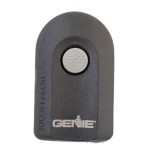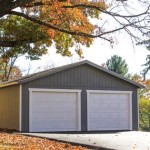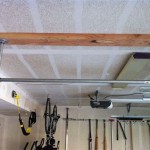How To Adjust The Height On A Liftmaster Garage Door Opener
The ability to properly adjust the height of a garage door is crucial for its smooth operation and longevity. A garage door that doesn't fully close leaves the home vulnerable to intruders and weather elements. Conversely, a door that closes too tightly can strain the opener mechanism, leading to premature wear or even requiring a replacement. Liftmaster garage door openers are widely used and are typically reliable, but adjustments are occasionally needed to ensure the door opens and closes correctly. This article provides a comprehensive guide on how to adjust the travel limits on a Liftmaster garage door opener, a process that essentially controls the door's height.
Understanding the terminology is important before beginning any adjustments. The term "travel limits" refers to the points at which the garage door opener stops moving during both the opening and closing cycles. These limits are programmed into the opener's control board and dictate how far the door travels up and down. Mechanical limit switches, typically found in older models, physically interrupt the motor's power at the set points, while newer models use electronic sensors and programming to achieve the same effect. Adjusting these limits ensures the door stops at the desired height, providing a secure and weather-tight seal when closed and preventing damage when fully open.
Prior to making any adjustments, safety should be prioritized. Disconnect the garage door opener from its power source. Finding the breaker in the electrical panel that controls the garage outlet and flipping it to the OFF position is the best approach. This prevents accidental operation of the door while working on the opener, which could lead to serious injury. Once the power is disconnected, manually disengage the garage door from the opener carriage. This is typically done by pulling the emergency release cord, a red handle hanging from the opener rail. This allows the door to be moved freely by hand, enabling accurate adjustments.
Identifying the Adjustment Mechanism
Liftmaster garage door openers utilize various mechanisms for adjusting the travel limits, depending on the model's age and features. Older models often feature mechanical limit switches, which are small screws or dials located on the side of the opener unit. These screws are typically marked with symbols or labels indicating their function – often an up arrow for the opening limit and a down arrow for the closing limit. Rotating these screws adjusts the distance the door travels in the corresponding direction. Turning the screw clockwise usually increases the travel distance, while turning it counter-clockwise reduces it. The user should consult the owner’s manual as the specific mechanism may vary.
Newer Liftmaster openers employ electronic travel limits, which are adjusted through the opener's control panel. This panel typically features buttons labeled "Learn," "Up," and "Down," or similar terminology. The adjustment process involves putting the opener into a programming mode, moving the door to the desired position, and then saving the new travel limit. The specific sequence of button presses may differ depending on the model, so consulting the owner’s manual is critical. The manual will provide detailed instructions on entering the programming mode and saving the new settings. Some models may also feature a small display screen that provides visual feedback during the adjustment process.
Furthermore, the type of drive system of the opener influences the adjustment mechanism. Chain drive openers, belt drive openers, and screw drive openers each have slight variations in their components and adjustment procedures. Chain drive openers are known for their robust construction and typically feature more straightforward mechanical adjustments. Belt drive openers, which offer quieter operation, may have more sophisticated electronic controls. Screw drive openers, characterized by their direct drive mechanism, might have a unique adjustment process suited to their design. Again, the model number is important and the corresponding owner's manual should be reviewed.
Adjusting the Down (Closing) Limit
Adjusting the down or closing limit is essential for ensuring a secure and weather-resistant seal. Begin by manually closing the garage door completely. Observe the gap between the bottom of the door and the floor. Ideally, the door should make solid contact with the floor without excessive pressure. If the door doesn't close fully, turning the down limit adjustment screw (on older models) clockwise will increase the travel distance. Make small adjustments, typically a quarter or half turn at a time, and then test the door's operation by using the wall-mounted opener button to activate the door.
For openers with electronic travel limits, the process involves entering the programming mode as described in the owner’s manual. Once in programming mode, use the "Down" button to move the door incrementally until it reaches the desired closed position. Ensure the door makes firm contact with the floor without compressing the weather stripping excessively. Once the door is in the correct position, press the "Learn" or "Set" button to save the new down limit. Test the door's operation by using the wall-mounted opener button to fully close the door.
If the door closes too tightly, causing the opener to strain or the door to bounce back up, the down limit needs to be decreased. For mechanical limit switches, turn the down limit adjustment screw counter-clockwise to reduce the travel distance. For electronic travel limits, enter programming mode again and use the "Up" button to slightly raise the door before saving the new down limit. It's crucial to make small adjustments and retest the door's operation after each adjustment until the desired closed position is achieved. Repeat the adjustments until a proper seal is achieved.
Adjusting the Up (Opening) Limit
Adjusting the up or opening limit is just as important as the down limit. This adjustment prevents the door from traveling too far up and potentially damaging the opener or the door itself. Manually open the garage door to its fully open position. Observe the door's position relative to the header (the top frame of the garage door opening). The door should open completely without putting undue stress on the opener. There should be sufficient clearance between the top of the door and the opener rail to prevent any collisions.
For older models with mechanical limit switches, turn the up limit adjustment screw clockwise to increase the travel distance and counter-clockwise to decrease it. Begin by making small adjustments, a quarter or half turn at a time, and then test the door's operation by using the wall-mounted opener button to open the door. Observe the door's movement and position as it approaches the fully open point. Stop the door if it appears to be traveling too far or is straining the opener. Readjust the up limit until the door opens fully without any signs of stress or binding.
For openers with electronic travel limits, enter the programming mode as described in the owner’s manual. Use the "Up" button to move the door incrementally until it reaches the desired fully open position. Ensure there is adequate clearance between the top of the door and the opener rail, and that the door opens completely without excessive strain on the opener. Once the door is in the correct position, press the "Learn" or "Set" button to save the new up limit. Test the door's operation by using the wall-mounted opener button to fully open the door. If the door still doesn't open completely or strains the opener, repeat the adjustment process until the desired result is achieved.
After adjusting both the up and down limits, it is important to perform a complete cycle test. Operate the door through its full range of motion, from fully closed to fully open and back to fully closed. Observe the door's movement carefully, paying attention to any signs of binding, straining, or uneven movement. Listen for any unusual noises emanating from the opener or the door itself. If any issues are detected, re-examine the travel limit adjustments and make any necessary corrections.
In addition to adjusting the travel limits, the force settings of the opener may also need to be adjusted. The force settings determine the amount of force the opener applies when opening and closing the door. If the force settings are too high, the opener may continue to operate even if the door encounters an obstruction, potentially causing damage. If the force settings are too low, the door may reverse direction prematurely. The force settings are typically adjusted through the opener's control panel, and the process is outlined in the owner's manual.

Chamberlain Liftmaster Travel Limit And Force Adjustment

Chamberlain Liftmaster Travel Limit And Force Adjustment

Set Garage Door Travel Max Up And Down Liftmaster Myq

Chamberlain Liftmaster Travel Limit And Force Adjustment

How To Set The Travel Limits Force On Liftmaster Models 3850 3800

How To Adjust Force On A Liftmaster Garage Door Opener With Manual Adjustment Controls

The Down Force And Travel Limits Of Garage Door Openers

How To Adjust Your Garage Door Height

How To Program Travel On Liftmaster Security 2 0 Garage Door Opener

How To Install A Liftmaster 8500 Door Opener High Lift Inc
Related Posts








